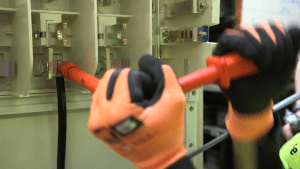July 14, 2025

Introduction
In the career of an electrician, there are routine tasks, and then there are tasks that demand our utmost respect and concentration every single time. Working on the domestic service head and the main cut-out fuse falls firmly into the latter category. This is the demarcation point between the wider distribution network and the customer’s installation; it is, for all intents and purposes, the electrical “point of no return.”
This task is performed daily by thousands of professionals, but its familiarity should never breed contempt. The potential hazards are significant. This guide serves as a safety masterclass, reinforcing the procedures and the non-negotiable role of high-quality insulated tools in this critical zone.
Understanding the Inherent Risks
Why does this specific task demand such a high level of caution?
- Upstream of the Main Fuse: This is the crucial point. You are working on a circuit where the only upstream protection is the fuse at the local substation. The Prospective Fault Current (PFC) can be extremely high, meaning a short circuit will be violent and explosive.
- Significant Arc Flash Potential: Due to the high available fault current, a short circuit between live conductors or to earth can initiate a dangerous arc flash event, even at 230V.
- Age and Condition of Equipment: Many service heads and cut-outs in the UK’s housing stock are decades old. Bakelite can become brittle, connections may have been disturbed, and you can never be certain of the internal condition until the fuse is withdrawn.
- Confined Spaces: This work is often carried out in cramped, poorly-lit under-stairs cupboards or external meter boxes, increasing the risk of accidental contact.
The Non-Negotiable Toolkit for the Job
There is no room for improvisation here. Using the wrong tool is not just inefficient; it’s a direct risk to your life. The following VDE/IEC 60900 certified insulated tools are essential:
- Insulated Fuse Carrier Pulling Pliers: Standard pliers are not acceptable. Specialised fuse pulling pliers are designed with jaws that correctly grip the lugs on the fuse carrier. This ensures a firm, straight pull, reducing the risk of the carrier shattering or slipping. Their insulation is, of course, paramount.
- VDE Insulated Screwdrivers (Slotted & PZ2): Absolutely essential for disconnecting and reconnecting the meter tails. The insulation on the screwdriver’s shaft is critical to prevent it from accidentally bridging the live incoming terminal and the neutral or earth terminals within the cut-out. VDE Slim variants are often required to access recessed screw heads without the insulation sheath getting in the way.
- An Approved Voltage Tester & Proving Unit: A two-pole voltage indicator compliant with GS38 guidance is mandatory for proving the circuit is dead after withdrawing the fuse. The “Live-Dead-Live” testing procedure must be followed without fail.
- A High-Quality Head Torch: You cannot make safe what you cannot see. Proper illumination of the confined workspace is a basic safety requirement to avoid errors.
Why Tool Quality is Your Last Line of Defence
In this zone, your tools are not just for performing a task; they are active safety equipment.
- Insulation Integrity is Everything: A small nick or crack in the insulation of your screwdriver could be fatal. The superior durability and toughness of advanced materials like the Nylon Thermoplastic used by ITL provides an extra margin of confidence and safety in these high-stakes situations.
- Precision Matters: A well-machined screwdriver tip that fits the terminal screw perfectly prevents slips. A slip here could have devastating consequences.
- Guaranteed Performance: When your personal safety relies on a tool, knowing it’s backed by a Lifetime Warranty provides the ultimate assurance that you are using equipment built to the highest possible standard, designed never to let you down.
Conclusion: Respect the Responsibility
Working on a service head is a direct interaction with the raw power of the distribution network. It’s a task that perfectly encapsulates the responsibility of our trade. It requires procedural discipline, unwavering focus, and absolute trust in your equipment. There can be no compromise on the quality, condition, or certification of the insulated tools you use. Investing in premium, certified tools is a direct investment in ensuring you go home safely at the end of every day.
For the tasks where safety is absolute, trust nothing less than the best. Explore our range of VDE-certified insulated tools, engineered for the critical demands of DNO and domestic electrical work. https://insulated-hand-tools.co.uk/shop/
